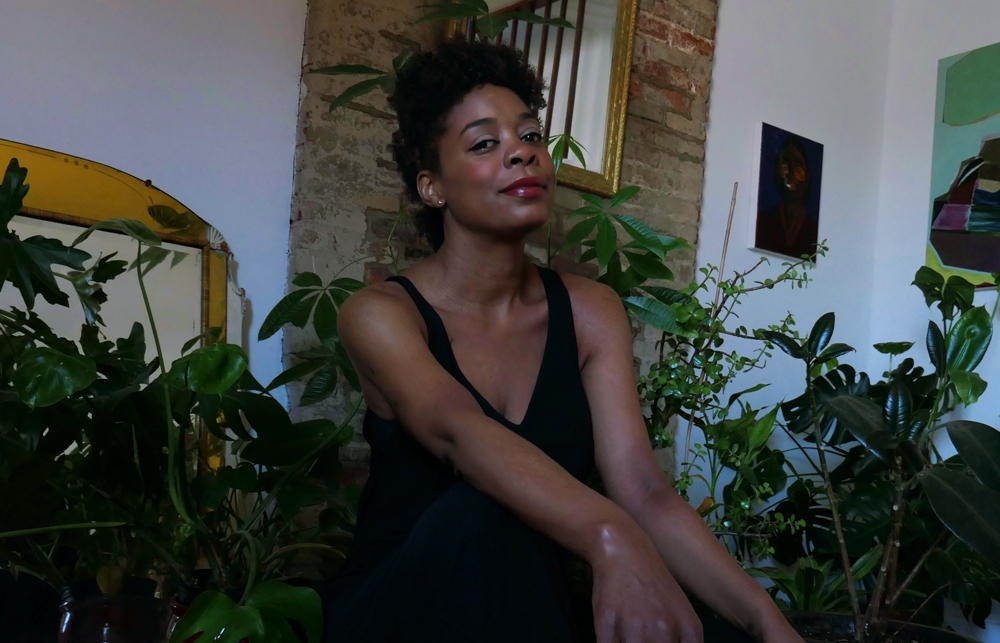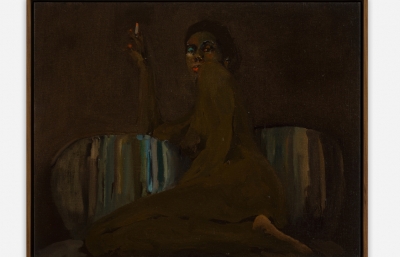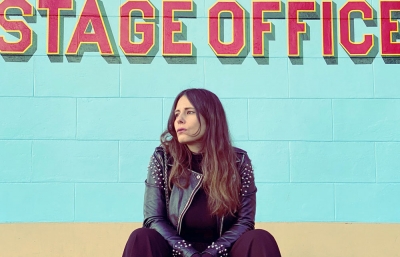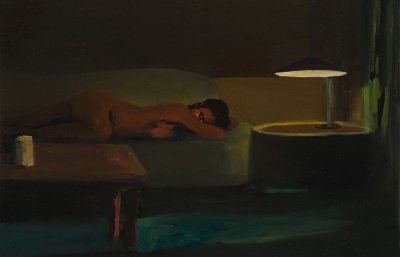Danielle Mckinney
Comfort and Quietude
Interview by Kristin Farr // Portrait by the Artist
To question how the pandemic changed an artists’ work can feel trite—until the answer is miraculous. Danielle Mckinney made photographs, primarily, until the time confined at home found her painting in earnest with a raw, natural energy that had been quietly waiting to be fully unleashed.
Mckinney’s photography is already remarkable; look up The Guardian to see how her creative lens eases between camera and paint. Reclusive moments of deep reflection, introspection and wonder come alive in her work, moods that have simmered all along as her new recipe arrives at the perfect temperature. Mckinney’s legacy is already rich with heartfelt interpretations of a universal sensibility.
Kristin Farr: What are you up to?
Danielle Mckinney: I’m trying to finish up these paintings for Fortnight Gallery. I’ll try to do one more today, and then spend some time with my husband. It’s good weather, and I’m glad it’s warmer.
Tell me more about your process.
Sometimes I’ll use a photo reference from Instagram or Pinterest. I’m always on my phone with social media, anyway, so when I see a photograph or something, it’ll trigger me to use it as a reference. Or I’ll see a painting when my husband and I are at The Met, and I’ll find a style that I like. What happens is I kind of project myself into it. So it’s like the photograph is the reference, and the painting becomes my way to actually make that image myself, so they’re kind of autobiographical in that way.
Sometimes I don’t even see them as myself; it’s just that I want them to be another figure, to change them up in some way. Somehow the photo sets the mood.
When I was little, I used to build these houses out of shoeboxes. I would take my grandma’s interior design magazines and cut things out, and put the house together first. The last part, which I really enjoyed doing, was to cut out some people from the page, a little family, and put them in this house. So it’s kind of the same thing I’m doing with the paintings. I’ll use the photo as a reference, and I’ll put the figure in this environment, and freeze her in this moment.

You made dioramas! Did you have siblings?
No, I was an only child. I would spend hours doing that. My mom even said my paintings are similar to what I did when I was a child. My family would be around, but I would be in a room for five hours with these houses, so I think there was comfort in controlling these little environments. I could say, “This is the living room, and I want it to look this way, and I want you to sit here.” They became these worlds for me.
The figures in your paintings often appear solo but seem preoccupied by relationships.
Exactly. They are in these environments, but it’s not like where you see an architecture photo, and there’s a figure talking about the space and the spatial dimensions. Figures are a way for me to find solace or comfort in these interior environments. It’s really reflective of thoughts, emotions, or things that have happened. Smoking a cigarette in silence with your own thoughts, or having a Negroni and feeling warm and fuzzy on the inside—they’re very inner-reflective and based on things that have triggered me in my own life.
Let’s talk about smoking cigarettes.
I’ve always smoked. I started when I was young. It was a cool thing to do when you were a teenager, and I continued to do it. Smoking in the paintings is the guilty pleasure for my addictions. People are always shocked when they find out I smoke. My family doesn’t like that I smoke. Cigarettes take me to a very introspective place. When I’m smoking a cigarette, the mood is already set, so the paintings allow me to be honest and freely admit I smoke cigarettes. I enjoy it, and they’re part of these moments with me. They’ve been there. When I’m happy, I smoke, when I’m sad, I smoke, when someone passes away, I smoke…

Smoking goes well with painting, too.
Completely. I’ll finish a painting, and if I feel it’s great, the first thing I’ll want to do is smoke a cigarette downstairs, come back up and look at it. The cigarettes are such a part of me, even when I try to quit or vape sometimes—I couldn’t deny the truth about myself. Even though the figures are not exactly self-portraits, I was like… they smoke cigarettes.
For whatever they might be thinking, it’s an adaptable prop.
You smoke too, so you understand. You’re the first person I’ve talked to that gets it. Everybody will ask about the cigarettes in the paintings, but unless they smoke, they don’t get it.
I do meditation but I still have that euphoric feeling—even some of the figures are referencing that meditative spirituality. I can be thinking or get ideas, or something happens, and I’ll just need a cigarette. Or if I’m driving to Target with good music on, I’ll want to smoke a cigarette to it.
It’s a good seven-minute break when you’re busy. I know this should be about your art…
This is about the art! It is. It’s not just about taking a deep breath but about holding it in our hand, the smell of it and the rush that you get with a cup of coffee… it’s a whole thing.
Even if I’m at a party and there’s nobody smoking, I’ll disappear for ten minutes. I’ll have perfume and gum, and just go on with life. It’s a booster, but the strange thing is, my mom has said, “Can we not put the cigarettes in the paintings anymore? Can they not be smoking?”

She doesn’t want you to smoke.
Exactly. She wants to see pretty paintings with flowers. I work with a lot of naturalists and herbalists who say smoking is bad if you make it bad. I’m pretty much 100 percent healthy the rest of my life; vegetarian, supplements, herbs. Smoking is just… you know.
Another artist told me smoking is less bad if you have a healthy diet.
I try to tell that to myself.
Here in California, smoking is frowned upon.
In New York, it’s everywhere. Everybody has a cigarette or a vape. Moving from the South, I was around a lot of artists and writers and going to lectures; afterwards there was this gathering of smokers for intense conversations.
I think that’s why I did Self-Portrait with Vape, because it was this artificial glowing USB cable, and I was like, what is this? I was hiding it, so that painting was really this figure vaping, and then hiding behind this little glow, this chemical. It’s all strange.
Vaping is not the same.
At that point you might as well smoke. Just go ahead and smoke.

It’s gotten me through a lot.
Me and you both. It is so therapeutic to have this conversation with you because I’ve done interviews with people where it’s the first thing they want to address but they aren’t comfortable with an intimate conversation around it. I think they assume because the figures are smoking, that it is in an addictive way. It’s a symbol of the work almost, so thank you for understanding that it’s really about these intimate moments… seven minutes.
Also, what you were saying about how they’re thinking about someone else—I can really understand and articulate from that viewpoint, so thank you.
Thank you. We’ll smoke together one day. What’s something important to you that seems less important to other people?
Silence. I don’t know if that is less important to other people. It depends on the person. I get very irritable if I’m not quiet. I think, because I’m an only child, I grew up quiet, and I need that kind of silence. Some people really need to talk and share, go on and on, or ride in a car and talk the whole way. For me, silence is something I really value a lot, that ability to slow down.
What was the catalyst that led you to pivot from photography to painting?
I’d done photography for 20 years. My undergrad and grad school at Parsons was in photography, and that’s why I moved to New York from The South. I had a big, successful piece called The Guardian, which I exhibited, and I did a video work along with it. It was about the public and social space, intimacy, really, like when you cross through someone’s boundary, they might freeze up when you go to touch them. I was really fascinated with that. I worked as a sociologist via photography. Even when I was doing photography, I’d paint on the side. I always painted these figures. They were always there. When the pandemic hit, I’d try to force myself to make photographic work, to follow those educational and conceptual ideas I’d been trained with formally in grad school, and I just had an anxiety attack. I was, like, I can’t do this anymore. I can’t shoot. I can’t keep looking at the world. And then my cat passed away, and I was stuck in the house, and I was going to break down if I didn’t do something creatively. So I went to Michael’s, bought a whole bunch of canvases, and I just painted.
My husband is a painter. He’d be like, “More brush strokes, honey. That looks great.” It started to boost my trust, and then I took a class here in New York called the Crit Club. I had an excellent teacher who told me, “I don’t know why you never exhibited your work. You really have something special.” In the beginning, I was sensitive, and she said, “Build a wall. Don’t let anyone in, just paint, paint, paint.” She helped me trust my own style, and not compare my work to other painters. She’d tell me my lines were unique; she said “This is the way you paint, and the more you paint it will evolve,” so I started to trust my process. And I trusted her, so I put it out. I was, like, why not share? So, I shared it, and that’s how it happened.

You were painting with light in the photography work, in a sense. The Guardian photo has a similar mood to the paintings. How do you challenge yourself in the studio? I noticed you were pushing yourself to use the color red recently.
I challenge myself, especially with color, because I’ll paint, and then think, well, what color? And then I’ll have a panic attack in regards to what color the background should be. There’s a harmony with the colors. They have to ring true together, and/or create this vibrational tone to the work. I’ll try to think of her skin color, and it’s hard because, even though I use a photo source, I don’t have those colors. My husband is able to just mix oil colors together and match a color. I have to use the exact tube of paint. I can’t just make aqua. When I did that painting with the red, it was really challenging because red is such a robust color. It can panic me. So I decided to challenge myself by using colors that I’m not comfortable with to really create an atmosphere.
What are comfortable colors for you?
There are three. I’ve noticed that pattern. As soon as I sit down, I’ll take out red oxide, which is an orangey-red, and burnt umber and black. I paint the canvases black before I even start. Black is a color that, even with photography, I use to bump the contrast. I look for the black tones in black-and-white photos because it has that shadowy kind of depth that I can create and contrast, and corner those colors the way I want. Sometimes I can be a little overpowering with the black, and that’s where my husband has helped by telling me not to be so heavy with the lines in black, and maybe use it to add shadow. But black is my favorite way to frame and contour, and add that contrast.

I love your painting called We Need to Talk. Tell me about the mood and the fashion.
I’m really influenced by art deco fashion, which, to me, always just makes such a strong statement. The women in these fur jackets were just like, wow, protective, classy, in their moment—don’t touch me, don’t talk to me. But I always want to throw things off a bit, because I don’t want them to always be so perfect, so I gave her blue tights. She’s gonna be in her little chair, with her little fingers with her red nails and a cigarette—and her blue tights—and it’s really about that moment where you’re pissed but don’t want to show it. You’re still looking “A-Class,” as my mom says, but inside, you’re in your own little world. It’s the fashion, the way she’s in her fur coat, her cigarette, her blue tights, the gesture of her leg curled up into herself, but then the vulnerability. She doesn’t want someone to talk to her, so the outfit is her protection, but also her desire to be understood.
The colors and the timelessness are so memorable. Tell me about the spiritual references in some of the paintings.
I was raised Southern Baptist. My father was a Baptist preacher, and I’m from Alabama, where it is a heavy part of the culture. Throughout my life, I’ve struggled to find where I fit in spiritually, though I do have a spiritual connection. I think I still use these symbols in my work of the white male dominant Jesus with a beard or the Virgin Mary, because they are traditional symbols representing spirituality or religion. They’re still a big question to me, and still such a big part of me that it comes out in the work.

Your painting Facade, with the arms wrapped around an antiquated bust—is it related to your studies of art?
I have an affinity for the past. I lived in Europe for a long time, my husband is from The Netherlands, and I have an affinity for history. Anything old, I become obsessed with and project stories onto it. With Facade, it’s this old Roman Greek sculpture, but if you look closely at her face, it’s like I’ve made history alive. It’s the desire to take something old and make it alive again. Even when going to a museum, I can stay there for hours…
Do your titles come naturally?
When I finish the work, I’m like, OK, who are you? What are you saying? What’s going on here? Because I have no idea until I finish. It’s like I go into a mad world, and then I finish it. And then I spend time with the figure. I’ll take a little piece, not to tell everything, but to tell the story of what may be going on. I already try to make it not too introspective or so much about myself that people can’t engage in it. The titles are a way for me to give them meaning after I live with them.
The paintings already talk to you.
Yeah, they do.
Do you ever start over?
I’ll just paint it black. If it’s not right, I’ll say, “Oops, you’re not doing it, so, here you go, back to black.” Some paintings might have four more paintings underneath them.
Danielle McKinney opens solo shows at Night Gallery in Los Angeles on May 22, 2021 and Marianne Boesky Gallery in Aspen, Colorado on June 10, 2021.






